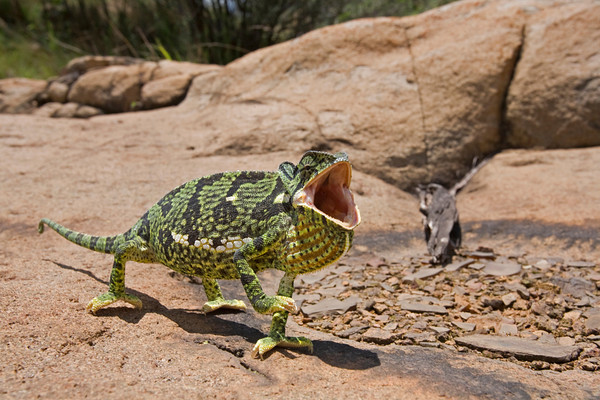There are about 200 species of chameleon with 19 recognised species in South Africa. They are found all over Africa and Madagascar, with a very few occurring
in Europe or the Arabian Peninsula. There are no true chameleons in
America except, interestingly, a species of chameleon that was imported
into Hawaii and has now established a flourishing population there.
The most important fact about chameleons is they need a fairly large area in which to roam. In Johannesburg, gardeners are being encouraged to link up chameleon-friendly gardens in a single neighbourhood. It is hoped that these gardens will merge to create corridors of chameleon habitat which will make it possible for populations of chameleon to flourish.
Here are some tips for developing a chameleon-friendly garden:
- Reduce your lawn. To a chameleon, a large lawn is a giant desert. It contains no food, has no perches and no protective cover.
- Thin out your trees. A garden filled with trees with low-hanging branches is a nightmare for chameleons. The branches of trees (pines and oaks in particular) are too thick for the chameleons to move along. They attract little insect life and offer no nectar.
- Plant large thin-stemmed shrubs. Heaven for chameleons is a garden filled with a dense under-storey of shrubs with a range of perch sizes for juveniles and adults.
- Provide food. Chameleons eat small insects such as moths, butterflies, flies, fruit flies, aphids, woodlice, beetles, spiders and small grasshoppers.
The best way to attract
chameleons to your garden is to make sure that the soil is covered in a
thick mulch of compost, decaying autumn leaves and woodchips. This rich forest floor environment will attract an entire microcosm of insect life, and chameleons will arrive.
- Develop a compost heap in a quiet corner of the garden with the precise purpose of breeding insects. Baby chameleons will relish the tiny flies, grubs, beetles and gnats that thrive around a compost heap.
- Build an insect hotel. Very fashionable in Europe, insect hotels are artistic columns or cubes of plant material that are glued or wired together. The common theme is that each material must be considered a suitable home by respectable insects and spiders. A hotel could include a mishmash of pinecones, hollow bamboo stems, lotus pods or even old pieces of wood with holes of different sizes drilled into the stem.
- Plant flowering shrubs. Chameleons thrive in a garden that has a complete ecosystem of small, medium and large flowering shrubs which are constantly attracting insect activity. Smaller flowering shrubs covered in flowers are particularly loved by insects and are regarded as food table bridges between large twiggy shrubs. Many of the honeybee-friendly plants, such as euryops daisies, ribbon bushes, sage, fireball lilies, gazania and vygies will attract a variety of insects.
- Plant large shrub trees: Adult chameleons thrive in the higher perches found in large shrubs or small trees such as the dune crowberry, pompon trees, sweet thorn acacias and wild olive.
- Remove predators: Cats are one of the biggest threats to chameleons, birds and microfauna in the garden.
- Avoid using pesticides that kill flies, crickets, ants and micro-insect life that chameleons rely on for their food.
- Avoid illegal traders. If you see indigenous chameleons for sale, they are not legal. You are urged not to buy them.
A chameleon-friendly garden is as much about the structure of the vegetation as it is about the plants. This notwithstanding, here is a list of chameleon-friendly plants:
- Low-growing groundcovers: Try the lilac carpet geranium (Geranium multisectum), gazanias, bulbine, dwarf agapanthus or kingfisher daisy.
- Shade-loving shrubs under trees: Try the spurflower (Plectranthus spp.), asparagus fern (Asparagus densiflorus), ribbon bush, arum and fireball lily.
- Low-growing shrubs with thin branches: Confetti bush, euryops daisy, tea bush or azaleas.
- Larger shrubs with thin branches: sage bush (Buddleja salviifolia), hop bush, mahonia, lion’s ear, polygala or dune crowberry (Searsia crenata).
Chamaeleo dilepis (Flap-neck chameleon) - The Flap-neck is the most common chameleon found in Gauteng (South Africa). The colouring here indicates that it is not feeling threatened but the change of spots is getting ready, just in case!
Image credit - Here it is quite clear that he is very upset and not impressed at all!
It is very difficult to tell the different species apart. At first glance, they all look quite the same - all small, greenish-brown, with rolling eyes. But on closer inspection, it appears that there is a large amount of colour and scale variation, even within the same species. Luckily, with the help of genetic tests, it is now possible to make a better distinction between species, because each one has its own specific DNA code.
This makes further work on the morphological differences between species possible.
This makes further work on the morphological differences between species possible.
Any animal that can change colours and look in two directions at once is
worth learning more about. Armed with a tongue you have to see to
believe, the chameleon may be one of the coolest reptiles on the planet. I can only pray that in generations to come, chameleons can still be found roaming the trees of South Africa freely.
Together we can make a difference.
(Source for most of the information from the internet.)
(Source for most of the information from the internet.)















































